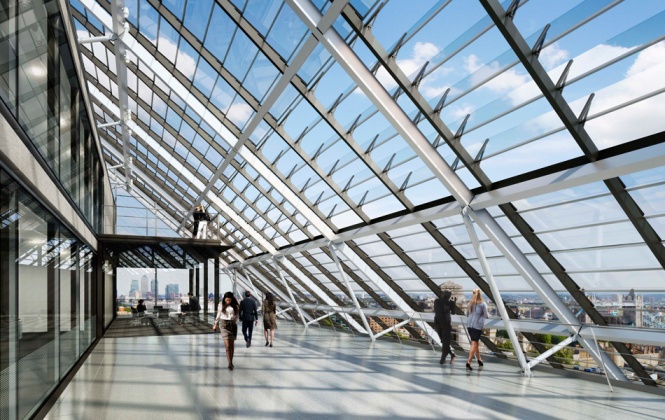Central London commercial property researcher, Sophy Moffat, is an expert in real estate market trends. She is currently the head of the Central London research team at DTZ (recently merged with Cushman & Wakefield), which offers investors, tenants and developers industry knowledge, in order to help them find the best solution to their accommodation needs.
Sophy will be speaking at this year’s Social Workplace conference in London, and we caught up with her to learn more about her latest research project ‘How You Work’.
Hi Sophy, what are the current trends you are seeing in the real estate and commercial property market in London?
Firstly, there are attempts to attract and retain talent in the face of global skills shortages, which means many businesses are taking a more employee-centric approach when it comes to real estate. Ultimately, this means that they are placing increased emphasis on workplace strategy and design.
Secondly, the head count in high-cost locations is under review; many firms are thinking about what roles need to be located in New York, London and so on. Also, many businesses are opening or expanding into additional hubs in more affordable locations.
Thirdly, technology is of growing importance. It helps ensure that tasks are simple, space is optimized, and remote working and cross-border collaboration are possible. Making room for flexibility and fostering innovation, as well as technology helps to optimize space and ultimately reduces real estate costs.
Overall, the trends we are seeing are centered on workplace strategy and design, as well as technology-enablement, location, and cost.
What do today’s tenants expect from a commercial property? Have those expectations changed in recent years?
In London and other gateway cities, the majority of global businesses we work with seek Grade A office space. That’s usually a given. It’s the social aspect – outside spaces, work-hubs, breakout areas, atriums, gym-quality services – that are of growing importance. This is because the world of work is changing: the ‘social workplace’ is no longer sought by the tech, creative and media sectors alone, but by a growing pool of large corporate tenants. Additionally, technology companies may have been first to customize their own unique experience around a core product and there is also a growing expectation that property should work like that too.
How has the transition from traditional office space to the “social workplace” affected the property market? Has it been a positive change? If so, why?
Having a more social, employee-oriented office is generally seen as positive. Perhaps most exciting for gateway cities globally is the fact that the ‘social workplace’ is playing an integral role in urban regeneration. When we look at regeneration schemes and concepts including King’s Cross in London, Dumbo Heights in Brooklyn, Factory Berlin and Fuxing Plaza in Shanghai, it can be seen that flexible office providers like WeWork and The Office Group, who epitomize the ‘social workplace’ are early stage tenants of this movement.
Thus, forward-thinking developers will choose to incorporate a social aspect, knowing that the vital injection of business diversity that stimulates many of the economic and social dynamics is needed in the workspace.
What have coworking spaces and social workplaces done for commercial property? Have they improved their value? If so, how?
So far, there aren’t many hard and fast stats on coworking because it is a relatively new industry. But, it is clear that the adoption of Activity Based Working – which has been the subject of various research studies does create value.
In 2002, Deutsche Bank started to introduce ‘db Smart Office’ – a new way of working within the organization that provided a wide range of settings to support the full spectrum of working tasks, from collaborative team space, to heads-down working areas. The aim was to help promote a multi-functional use of office space, encouraging communication, flexibility and also privacy.
The benefits so far have include reduced occupancy costs, due to reduction in spatial requirements projected to be between 10-30%, recouping of associated project costs within only 24 months due to savings made. We have also seen improved employee productivity at work, better technology in the workplace, and the ability to increase employee populations without additional real estate expenses. So yes, encouraging communication and flexibility do seem to create value!
What changes does the commercial property market have to make in order to meet the needs of today’s worker?
As businesses adjust to the realities of increasing rents and the rapid pace of a globalized, technology-enabled market, one of the biggest challenges they face is people. Businesses will find that ‘social workplace’ trends are not simply about creating open plan layouts or adding cafés, but also about giving people control and flexibility in their environment. This is all about enabling connections and creating a community beyond corporate meetings, as well as allowing employees to work in ways that give them meaning, and purpose.
The principles embodied by the ‘social workplace’ can help surmount a range of challenges. As Jay Cross, president of Related Hudson Yards, puts it: “You not only want to have a smart phone today — you want to live in a smart building and a smart community”. What the commercial property market has to do is keep up with tech, design, and new workplace strategy trends.
What will you be speaking about at this year’s social workplace conference?
I will be speaking about our latest research project ‘How You Work’ which, explores the trajectory flexible offices have taken by analyzing growth determinants and assessing the impact of modern cultural trends on the demand for flexible working.
The report shows how companies in New York, London, Shanghai, and Berlin are using flexible workspaces to share resources, reduce infrastructure spending and increase employee efficiency. It will also look at how talent recruitment and retention are critical drivers of the flexible office market. www.dtz.com/howyouwork
Amanda Gray





0 Comments